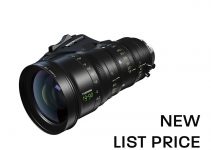The public beta version of DaVinci Resolve 12.5 was released only a few days ago, but it already created a lot of buzz and excitement among professional colorists and editors alike with its countless new features and enhancements. Our friend Alex Jordan of LearnColorGrading was among the first who managed to play around with the latest beta version of the software and even created a quick video walkthrough that we share below.
In the video tutorial, the Dubai-based filmmaker offers his personal perspective on some of the most appealing new features of the platform. Particularly, he’ll run us through the new capabilities of Resolve’s Tracker as well as the newly added temperature and tint controls in the Color Page, the customizable built-in presets for common output formats and more.
Unlike the older version of the tracker in Resolve 12, the users of Resolve 12.5 can now toggle between the Cloud Tracker and the Point Tracker. The Cloud Tracker is the advanced proprietary tracker that Resolve already has as a default feature, whereas the Point Tracker in the new addition to the Resolve 12.5.
In essence, the latter is designed to track very specific points or features of a moving subject in your frame that you need to follow. Unlike the Cloud Tracker, however, which automatically looks for all trackable points within a particular part of the image that you identify by using a Window, the Point Tracker lets you pick one or more specific points represented by crosshairs that you must manually position in the Viewer.
To utilize the new Point Tracker first create a new Node, navigate to the Window’s tab and choose the form of the Window. Now access the Tracker tab and in the bottom right corner from the drop down menu select the Point Tracker. Make sure that the window you want to apply the tracked motion to is selected before you begin tracking. Also, keep in mind that if you now start the tracking process nothing will happen. First, you need to create a tracking point manually by clicking on the Add Tracker button as shown below.
Move the pointer directly over the tracker crosshairs, and when it turns into the move cursor, click and move the crosshair to line up on top the subject you want to track in your frame. If you want to improve the accuracy of the tracking process, you can create more tracker crosshairs and position them on top of other details within the subject you tend to track. After creating and placing the tracking, points click the Track Forward or Track Backward buttons to initiate tracking.
The clip will be analyzed, and the Tracker graph will be populated with the tracking data as a result of the tracking process that is taking place. Keep in mind that in this case the Window is locked to the manually created tracking points. It also worth noting that the tracking points and the window don’t have to be placed in the same area of the image, so you can move the window anywhere in your frame.
If you liked this tutorial, make sure you also check out the Alex Jordan’s Resolve 12 color grading and editing courses by heading over to 4K Shooters Store. Currently, you can get the Color Grading & Editing Course Bundle with 58% OFF as well as the DaVinci Resolve 12 Simplified Course for just $99.
[source: Learn Color Grading]
Disclaimer: As an Amazon Associate partner and participant in B&H and Adorama Affiliate programmes, we earn a small comission from each purchase made through the affiliate links listed above at no additional cost to you.



